Exploring spiritual spots and recuperating in the mountains, home of the demi-gods: Audio guide for the Kibune and Kurama area
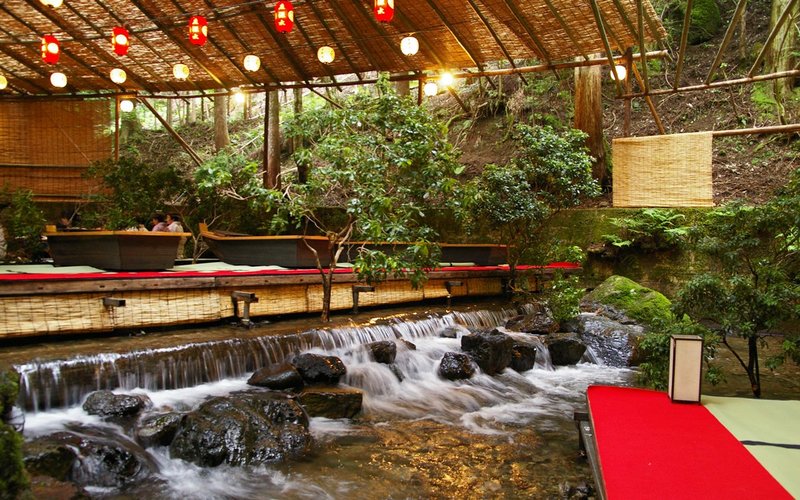
Kibune and Kurama area
Kyoto may be strongly considered the ancient metropolis, but you would be surprised by the rich natural landscape to be found just outside this busy city. One such area is the Kibune and Kurama area. There are temples and shrines renowned for their historical presence located at nearby mountain villages and streams banked by lush greenery. This area has been considered a spiritual spot since ancient times and is the birthplace of many legends and tales. The water and forests in Kibune fill the air with a palpable vitality that can be felt even in the confines of a living room. The area is considered auspicious for marriage, making it a popular destination.
Additionally, as legend has it, the towering Kurama mountains are the home of the Tengu, a Shinto demi-god. Like Kibune, Kurama is said to have restorative powers, but instead of drawing its energy from nature, it channels magical and mysterious spirits. The mountain is also a haven for those seeking an ascetic lifestyle.
So let’s take a stroll around the outskirts of Kyoto, enjoying the refreshing stream and maybe a meal at a hot springs inn. And if it happens to be fall, the cable car view of the Kurama autumn leaves is a must.
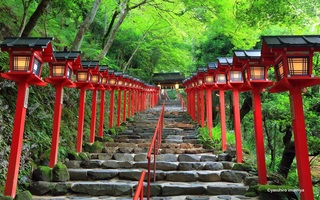
A Kifune Shrine
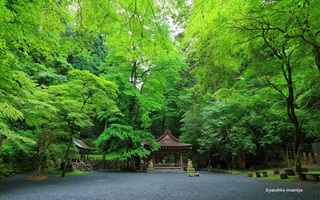
B Kifune Jinja Okumiya
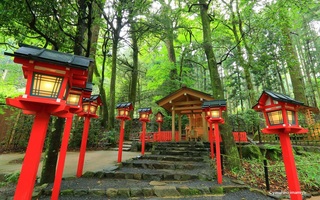
C Kifune Jinja Yui-no-Yashiro
D Kurama-dera Reihou-den
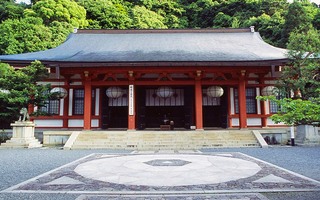
E Kurama-dera
F Kurama-dera Cable

G Kibune Kawadoko
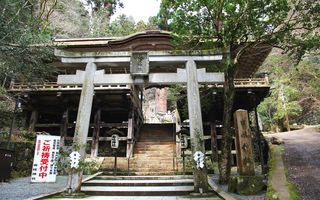
H Yuki Shrine
A
Kifune Shrine

Kifune shrine(Kifune-jinja), garnered a huge following as it was the source of water for Kyoto during ancient times and it is still strongly associated with water spiritually as well. Enshrined here is the God of water, Takaokami, the son of the Goddess Izanagi-no-mikoto. His mother, Izanami-no-mikoto, had originally given birth to the God of fire, whose flames tragically killed her during childbirth. His father then divided the god of fire into three Gods, one of which became Takaokami.
Water extinguishes fire, which is a metaphor for purifying one’s blood and believed to be part of the water God’s purpose.
Water is also the source of life and it is believed that the second God created from the God of fire was the Blue Dragon, God of the valley of darkness. The Dragon’s legend was born when water started gushing little by little from the bottom of a pond.
Kifune shrine consists of three main shrines scattered along the riverbank: the Hongu (main hall), the Yui-no-Yashiro (also known as the Nakamiya or inner hall), and the Okumiya (back hall). From ancient times, it has been transcribed as Kibune, meaning the spiritual root, as it is believed to be origins of the spiritual power “Ki.”
At almost any shrine, you’ll find “Ema,” or wishing plaques that literally mean “horse picture.” The plaques take their name from a rain ceremony performed here by Emperor Saga in which he sacrificed a live horse. You’ll also find water fortune telling, where you can have your omikuji read by floating an object on the surface of the Gojinzui pond and reading the characters that appear. Now, let's visit these three temples along the Kibune river.
B
Kifune Jinja Okumiya

Okumiya was originally the main shrine of Kifune and is known as the spiritual spot for a harmonious marriage. Lying right in front of the shrine are two cedar trees that are called the “Aioi no Sugi,” which have been growing side by side for over 1000 years. Beyond the Aioi no Sugi and over the Omoi river is the place where the great Heian poet Izumi Shikibu purified herself before praying. There is also another rare natural sight in from Okumiya: a cedar and a maple tree that have overlapped one another as they’ve grown, as if they were a couple embracing. The pairing of the two species is said to be unusual and believed to represent intimacy.
In Okumiya, there is a water well called the Well of Three Dragons under the main hall where the Dragon God resides. The spacious premises are surrounded by large old trees and the air itself feels sacred. You’ll feel as if you’re sharing the space with a strong spiritual presence.
Upon entering Okumiya, you’ll see the Funagata-Ishi (Boat Shaped Stone) on the left side. This stone symbolizes the arrival of the Goddess Tamayori Hime no mikoto. She arrived on a boat called Kifune and the pile of small stones marks where the boat was hidden. It is from the name of her vessel that the shrine takes its name.
The changing of the colors in the fall here is divine and there is a special lumination night tour only available when it snows. Another fun fact is that this very shrine is where the Japanese phrase “ushi no toki mairi” comes from. It refers to visiting a shrine in the dead of night in order to place a curse on someone. To avoid accidentally cursing someone, let’s remember to visit the shrine with positive energy and leave with good intentions of gratitude.
C
Kifune Jinja Yui-no-Yashiro

Since Yui-no-Yashiro is located between the Hongu (main hall) and the Okumiya (back hall), it is also known as the Nakamiya, or Middle Shrine. “Naka” means middle in Japanese. It is here that the Goddess of Matchmaking, Iwanaga-Hime-no-Mikoto, resides. Legend has it that both her sister Konohanasakuya-hime and her were sent to be wed to Ninigi-no-Mikoto, but he had her sent back saying she was too ugly. In spite, she stayed at this shrine in order to help others find their match. Her powers were then proven in another famed tale of romantic distress. Abandoned by her unfaithful husband, Izumi Shikibu, a Heian-era romance poet, prayed to the goddess with a sad love song. It is said that her prayers were soon answered as she was promptly able to reconcile with her husband.
The shrine is renowned as a place for those seeking special connections and there is no shortage of people with such desires.
Although no order has been stipulated by the Shrine, it is customary to first visit the main hall, then Okumiya and finally, Yui-no-Yashiro. It's not just about getting recharged at the powerful Okumiya shrine or securing a prosperous marriage; from childbirth to other relationships, it’s about tying all of your wishes together into one final knotted message that will ensure your wishes with good fortune.
In the past, people used Miscanthus sinensis to tie the knot with their wishes written on this thin leaf. Since the custom has done damage to the building of the shrine, those leaves have been swapped out for narrow cards called Tanzaku. So after you’ve had your fill of the other two shrines, why not do as the locals do and make Yui-no-Yashiro your last stop?
D
Kurama-dera Reihou-den
Reihou-den is the treasure room of the temple Kurama-dera. Opened in 1972, it is also known as the “Mount Kurama Museum.” The first floor is the natural science exhibition room of Mount Kurama, displaying the geological features and stratum of Mount Kurama as well as animals and plants. As this place is designated as a historical conservation and natural preservation area, the areas surrounding the temple have been largely untouched. Kurama-dera continues to protect these mountains and there is an exhibition room in Reihou-den.
As you go up to the second floor, there are the "Jihō room” and the “Yosano memorial room” where treasured articles such as paintings and books are displayed. The head monk of Kurama-dera was a disciple of famous female poet Akiko Yosano, who often came to visit. In the memorial room, boxes of Yasano’s writing and desks, which had been lovingly used by Yosano and her husband Tekkan, who was also a poet, are on display.
On the 3rd floor, there is a buddha room. Here you can see the Bishamonten statue, which is a national treasure, and the Sho-Kannon statue, which is an important cultural property. There is no doubt that you will leave with a richer understanding of Kurama-dera and Mount Kurama from this spectacular Reihou-den.
E
Kurama-dera

Kurama-dera temple is said to be founded when Gantei Shonin, the disciple of Ganjin Wajo, began worshipping the Buddhist god Bishamonten. Kurama-dera serves as the guardian of the northern part of Kyoto, the sacred land for mountain training and a renowned spot during autumn leaves season. It is here that you can enjoy the beautiful fall colors of the mountains from the precincts.
Emperors, aristocrats, and many female literary scholars have been visiting the Ryozen and Kurama-dera since the Heian period. It is widely mentioned in literary works of that time, such as the Pillow Book , the Sarashina Nikki, and even the Tales of Genji, as a meeting place.
The three Sonten, or spirits, of the moon, sun, and earth are enshrined at this temple. In front of the main hall “Honden Kondo,” there is a special Buddhist seal called the Kongosho at the center of a patterned, stone tiled floor. It is said that if you stand on the Kongosho with both of your hands and eyes towards the heavens, you will become one with the universe and have a wish granted. It is indeed an astonishing spiritual spot.
Here, you will not be greeted by the Komainu, but by the guardian guard Komatora, as he was a servant of the buddhist deity Bishamonten. Since it will be a steep climb to the main hall, you should use the cable car for part of the way and save your strength for the top.
F
Kurama-dera Cable
The shortest cable car ride in Japan can be found just as you go through the Niomon gate of the Kurama-dera temple. Because the main hall of Kurama-dera is in the middle of Mount Kurama, you have to climb a steep mountain road in order to reach the Buddha statues enshrined here. That’s why Kurama-dera Cable(Kurama-yama Kōsaku Tetsudō), the only religiously operated railway in Japan, was laid to provide easier access to the elderly and anyone else who needs assistance. The cable car only runs a total distance of 207 meters and is operated by Kurama-dera. The crew also wears the traditional working clothes of monks called samue. While the basic fare is technically free, a donation of 200 yen is encouraged for the cable car ride, being considered a token of gratitude. The name of the cable car is “Ushiwaka-gō” a common name on Mount Kurama, and this two minute ride connects the mountain gate to a spot called Tahoto. After that, you have to walk up to and climb the gentle mountain path of 155 steps. Enjoy the view as we climb, breathing in the fresh air of Mount Kurama.
G
Kibune Kawadoko

Seating out on kawadoko, or covered platforms just over the river, is a Kyoto summer tradition and you can see why. The water is so close, you could touch it just by stretching out an arm or a leg. Listening to the calm ripples of the Kibune river while enjoying a meal in a Japanese style room is truly a refreshing experience.
It is said that kawadoko came about during the Azuchi-Momoyama period. Kyoto basin has famously scorching summers even compared to the hot inner city area. The river’s average temperature, however, is below 10 degrees Celsius, so people built a bridge near the water to entertain guests. Along the riverbank, there are about 20 restaurants of various types, such as Japanese Traditional multi-course meal(kaiseki), river bed cuisine, nagashi somen and so on.
In cases of bad weather, entry to the river bed is closed off, but it is usually very popular and seats fill up fast. We recommend you check out the information pamphlets at local shops or ryokans and make reservations in advance. Let’s enjoy Kyoto cuisine on the river bed, staying cool and comfortable thanks to the natural air conditioning.
H
Yuki Shrine

Kurama Fire Festival, one of Kyoto's three major festivals, is held at Yuki shrine. It is an annual festival held on October 22 and the unique energy and burning flames of the grand torch Ootaimatsu are indeed a sight to behold. It is believed this shrine was founded during the Heian period, when Yuki Daimyōjin, which had been enshrined in the Imperial Palace, was transferred to the northern part of the capital due to the earthquake and public concern. Yuki Daimyōjin is also a god for the entire Kurama district. At the time, a torch was made from the reeds of the Kamo River and passed down along the road as an opening ceremony. Today, this custom continues to be a celebrated tradition as it is passed down to the next generation. The stone guard dog here is designated as an important cultural property. This statue is quite rare as it’s holding a child and it is believed to be a god of safe childbirth and prosperity for ones descendants. The hall of worship, or haiden, is also a rare site: the halls are split down the center by a corridor in a style called wari haiden. It is believed that Toyotomi Hideyori, the son of a famous warlord, built it. Osugi trees indicative of Mount Kurama are everywhere here. These Japanese cedar trees are also called the Osugi-san and it is believed that your wishes will come true if you to pray them. You can surely feel the energy exuded by these splendid giants. Let’s enjoy hiking while praying to these sacred trees.